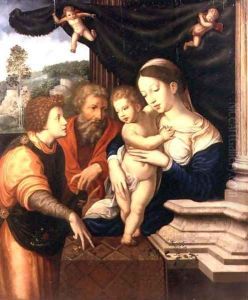(studio of) Cornelis van Cleve Paintings
Cornelis van Cleve, also known as Cornelis van der Beke, was a Flemish painter who was born around 1520 in Antwerp, then part of the Habsburg Netherlands. He was the son of the renowned painter Joos van Cleve, under whom he likely received his initial training. Cornelis became a master in the Antwerp Guild of Saint Luke in 1546, which indicates that by this time, he was recognized as a skilled painter in his own right.
The work of Cornelis van Cleve is characterized by religious themes, as was common in the period, and he is known for his altarpieces and devotional paintings. His style shows the influence of his father and other contemporaries, such as Pieter Coecke van Aelst and the Italianate influence that was becoming prevalent in the region. Cornelis's work is often noted for its vivid colors and expressive figures, which demonstrate a transition from the late Gothic style to the more dynamic and complex Mannerist style that was gaining popularity across Europe.
Although little is documented about his personal life, the historical records of his paintings and transactions with patrons suggest that he was a successful artist in his time. However, it appears that Cornelis's career was cut short, and his output was relatively limited. He died around 1569 in Antwerp. Since Cornelis did not have the same lasting impact as his father or other major artists of the era, his works were sometimes overshadowed and less studied.
Today, Cornelis van Cleve is recognized for his contributions to the Flemish artistic legacy of the 16th century, and his paintings can be found in various museums and collections. Scholars often attribute works to the 'studio of Cornelis van Cleve,' acknowledging the collaborative nature of art production at the time and the difficulty in distinguishing between the hands of different artists within a workshop setting. Despite the challenges in attributing some works, Cornelis van Cleve remains an important figure in the study of Northern Renaissance art.
